Biodiversity is the diversity of life from genes to ecosystems. Somewhere between these two extremes are habitats. Habitats are, simply speaking, an area where flora and fauna settle, live, feed, reproduce and die. More formally, marine habitats can be defined by a series of attributes, typically: geomorphology, benthic cover, architecture and taxonomy of structuring species (such as coral, algae and seagrass).
In the coral reef science literature, marine habitats are often simply described by mixing different attributes in a confusing, non-consistent way. Much of the coral reef literature focuses on only a small sub-sample of the habitats that are found in a coral reef environment. Typically this is the narrow seaward fringe of outer reefs and reef flats, which is often dominated by corals.
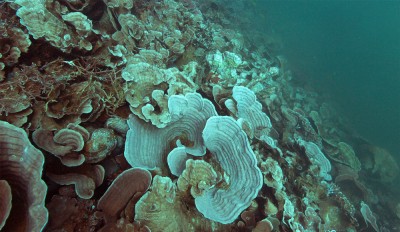
Foliose corals
Such biases conspire towards an oversimplification of a reef system, and how it functions. As a consequence, many descriptive and functional studies that looked at only few marine habitats, or even just a single one are often generalized as valid for all “coral reefs”. Clearly, this is not really acceptable. Once one has realized that a coral reef is made of a mosaic of tens to hundreds of habitats.
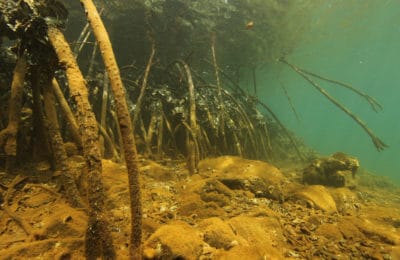
Mangroves
Marine Habitats and Biodiversity: Coral Reef Ecosystems are a Habitat Mosaic
Habitat mapping, generally using remote sensing images, considers the entire reef system. On the Living Oceans Foundation expedition, a specific team composed of Dr. Steve Saul and Rob Gardiner is dedicated to this very task. By creating habitat maps in many different places worldwide and ground-truthing different reefs and their entire mosaic of habitats, one can quickly realize that a reef can not be represented by one, or even a handful of habitats. The entire mosaic plays a role. As such, it is necessary to describe the entire range of marine habitats found in a reef, capture its diversity, and thus evaluate the representativeness of the sites studied.
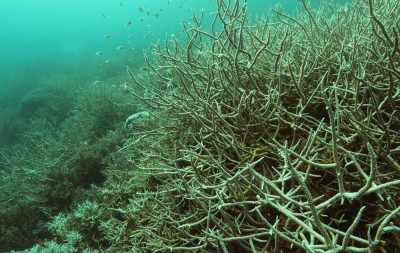
Dense and brittle Acropora habitats.
In New Caledonia, a habitat inventory has been amassed over the past couple of years. This process has yielded more than 220 types of habitats around the main island of New Caledonia, Grande-Terre. Recent surveys in Ile des Pins and Prony Bay in the south of New Caledonia will allow this on-going typology to be extended by habitats unique to these places. Specifically, the algal dominated marine habitats of Ile des Pins (https://livingoceansfoundation.org/unraveling-algal-biodiversity/ )}, and the unusual coral habitats of Prony Bay {https://livingoceansfoundation.org/red-reefs/}.
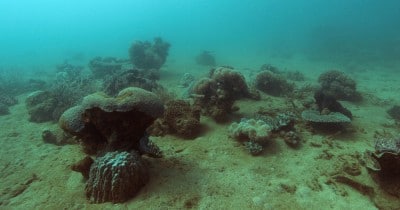
Isolated massive corals and table Acroporas.
In only 3 dives, from 2 to 30 meters depth, several new marine habitats were found in Prony Bay. The bay is however a very complex area and many more habitats likely remain to be discovered. The location is a large sheltered bay offering a variety of wind and wave exposures. The ferrous red hills that abut the shore contain high concentrations of heavy metals in the soils. The steep hillsides lead to high land erosion which enters the bay through several small rivers, while the south side of the bay is open to ocean swells. When it rains freshwater often collects at the surface in a distinct layer. These layers may persist after heavy rain and can kill coral communities. This can be seen as a sharp boundary between living and dead corals at a certain depth. The corals of these habitats are however fast growing and the boundary will disappear when corals grow back. Underwater, slopes of sediment can be seen, along with fringing reefs, islands, and also geothermal vents on the seafloor. These various exposures create different habitats, defined by communities specifically adapted to these constraints.
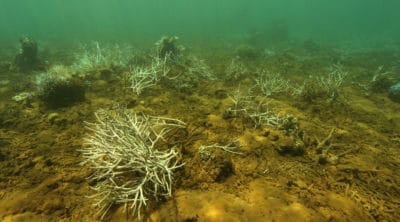
Red soil that enters the bay with a few Acroporas.
After the 3 dives in Prony Bay, a total of 18 marine habitats could be seen. Diving in the more exposed conditions at the entrance of the bay would have added new seagrass habitats, and different coral community structures. There are many deeper areas, below 30 meters, that we could not visit on this mission that contain valuable habitats, such as the geothermal events that are rare outside the bay. Prony Bay alone is may include up to 50 habitats and is a remarkable place for biodiversity.
After the surveys, we intend to conduct research in the atolls north of New Caladonia.Then we will be able to complete the habitat typology for the country.
Photos 1-5: Serge Andrefouet